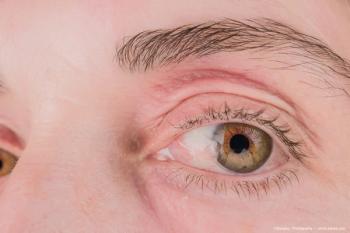
Alzheimer’s disease changes may be reflected in the eyes first
Learning more about the early AD stages, when brain damage is limited, should allow early and more efficacious treatment, and improvements in imaging may be able to pick up changes earlier.
Researchers from Cedars-Sinai Medical Center, Los Angeles, examined retinal and brain tissue from human post-mortem samples and found significantly increased amyloid β-protein and novel intraneuronal Aβ oligomers, which are associated with retinal pathologies.1
They pointed out that Alzheimer’s disease (AD) pathologies have been reported by their group and others in the neurosensory retina.2-5 However, the specifics of these pathologies remained largely unknown, especially early-on in the disease process.
The hope is that learning more about the early AD stages, when brain damage is limited, should allow early and more efficacious treatment, and improvements in imaging may be able to pick up changes earlier.
For these investigators, the
Investigations of retina and brain tissue
The 3 lead authors of the study,
They compared the findings from retinal samples obtained from patients with mild cognitive impairment and AD with those with normal cognition. The analyses showed “significant increases in amyloid β-protein (Aβ42) forms, which is key in AD, and novel intraneuronal Aβ oligomers (AβOi), which were closely associated with exacerbated retinal macrogliosis, microgliosis, and tissue atrophy. These pathologies were unevenly distributed across retinal layers and geometrical areas, with the inner layers and peripheral subregions exhibiting most pronounced accumulations in the tissues from those with mild cognitive impairment and AD versus normal cognition.”
Other notable study findings were increased microgliosis in the retinal tissue but decreased numbers of microglial cells amyloid β-protein uptake. Women with AD had more retinal microgliosis than men.
They also found, “retinal Aβ42, S100 calcium-binding protein B+ macrogliosis, and atrophy were correlated with the severity of brain Aβ pathology, tauopathy, and atrophy, and most retinal pathologies reflected Braak staging. All retinal biomarkers were correlated with the cognitive scores, with retinal Aβ42, far-peripheral AβOi and microgliosis displaying the strongest correlations.”
Inflammatory and neurodegenerative processes also were activated and oxidative phosphorylation/mitochondrial, and photoreceptor-related pathways were inhibited.
In commenting on their findings, the investigators said, “Our findings provide a novel and deeper understanding of the susceptibility of the retina to AD processes, including molecular, cellular, and structural abnormalities that can be detected in the earliest stages of functional impairment. Furthermore, our study has identified the pathological connections between the retina, brain, and cognition, proposing that the retina could serve as a reliable biomarker for non-invasive AD detection and monitoring.”
References:
Koronyo Y, Rentsendori A, Mirzaei N, et al. Retinal pathological features and proteome signatures of Alzheimer’s disease. Acta Neuropathol. 2023;145:409-38; doi:
https://doi.org/10.1007/s00401-023-02548-2 2. HartNJ, Koronyo Y, Black KL, Koronyo-Hamaoui M. Ocular indicators of Alzheimer’s: exploring disease in the retina. Acta Neuropathol 2016;132:767–87;
https://doi.org/10.1007/s00401-016-1613-6 3.Mirzaei N, Shi H, Oviatt M, et al. Alzheimer’s retinopathy: seeing disease in the eyes. Front Neurosci 2020;14:921;
https://doi.org/10.3389/fnins.2020.00921 4.Shi H, Koronyo Y, Rentsendorj A, et al. Retinal vasculopathy in Alzheimer’s disease. Front Neurosci 2021;15:731614;
https://doi.org/10.3389/fnins.2021.731614 5.Snyder PJ, Alber J, Alt C, et al. Retinal imaging in Alzheimer’s and neurodegenerative diseases. Alzheimers Dement 2021;17:103–111;
https://doi.org/10.1002/alz.12179
Newsletter
Don’t miss out—get Ophthalmology Times updates on the latest clinical advancements and expert interviews, straight to your inbox.













































.png)


